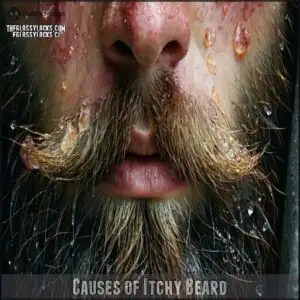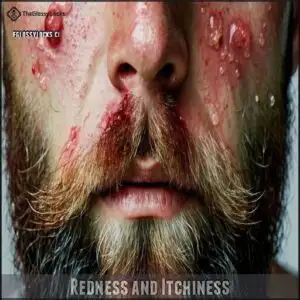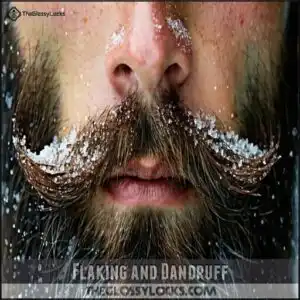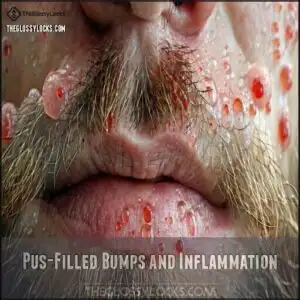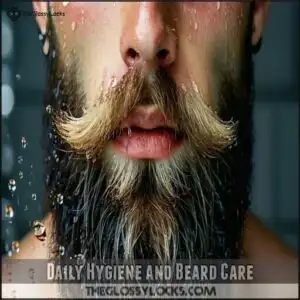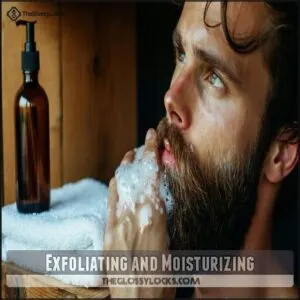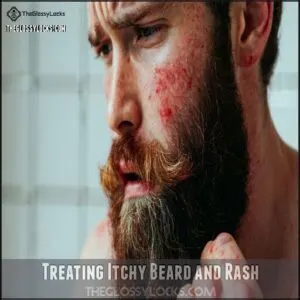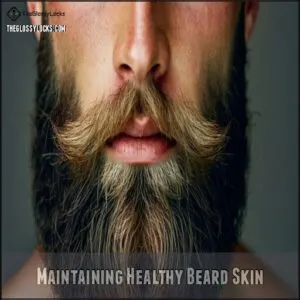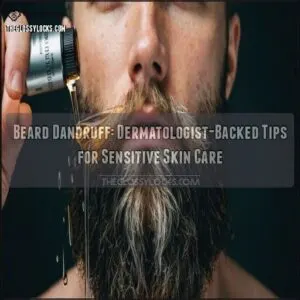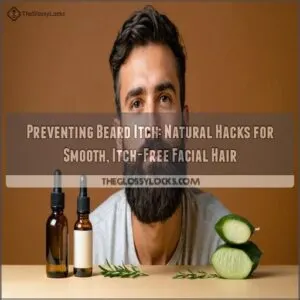This site is supported by our readers. We may earn a commission, at no cost to you, if you purchase through links.

Dry skin, ingrown hairs, or even fungal infections could be the culprits.
Start by washing your beard daily with a gentle cleanser, then moisturize with beard oil to keep your skin hydrated.
Exfoliate once a week to prevent clogged pores and pesky ingrown hairs.
Avoid harsh products—they can irritate your skin.
If the itch persists or you notice redness, flakes, or bumps, it might be time to see a dermatologist.
A little care goes a long way toward keeping your beard itch-free and thriving.
Table Of Contents
Key Takeaways
- Wash your beard regularly with a gentle cleanser and moisturize with beard oil to keep your skin hydrated and itch-free.
- Exfoliate weekly to prevent clogged pores, ingrown hairs, and flaky skin under your beard.
- Avoid harsh products and opt for natural oils like jojoba or argan to nourish both your beard and skin.
- See a dermatologist if you notice persistent redness, bumps, or flaking that doesn’t improve with home care.
Causes of Itchy Beard
Your beard itches because it’s collecting more than just compliments—it’s trapping dead skin cells, dry skin, product buildup, and possibly even tiny infections in your follicles.
Your beard isn’t just a style statement—it’s a magnet for dead skin, dryness, and hidden irritants causing that relentless itch.
You’ll need to understand these causes before you can finally stop that constant urge to scratch at your face like a bear against a tree trunk, and find a solution to the itching.
Dry Skin Conditions
Desert-like conditions beneath your beard often lead to that maddening itch.
When your beard feels like a desert, it’s crying out for moisture to quench the itch.
Xerosis causes your beard to feel like sandpaper when natural oils are depleted.
Weather effects, particularly cold winds and low humidity, strip skin hydration faster than you’d think.
Product allergies from new beard care items can worsen dry skin.
Daily skin moisturizers designed specifically for facial hair will balance your skin’s ecosystem, providing beard itch relief without clogging pores.
Ingrown Hairs and Folliculitis
Trapped beneath your skin, ingrown hairs occur when hair curls back and grows inward, especially common with curly hair.
These pesky intruders cause red bumps and beard irritation.
Folliculitis—inflammation of hair follicles—often follows, triggered by bacteria entering tiny cuts from shaving against the grain.
Proper razor hygiene and following the correct shaving direction can help prevent infection. Shaving against the grain increases this risk considerably.
For persistent skin inflammation, medical intervention might be necessary.
Seborrheic Dermatitis and Fungal Infections
While that telltale flaking and redness in your beard might be frustrating, seborrheic dermatitis often results from an overgrowth of Malassezia furfur on your skin.
Unlike tinea barbae (a true fungal infection caused by dermatophytes), seborrheic dermatitis responds well to antifungal shampoos with ingredients like ketoconazole.
For severe cases with scalp involvement, your dermatologist might recommend systemic treatment.
Tea tree oil can also help manage symptoms naturally.
Allergic Reactions to Skincare Products
Your skin care products might be the hidden culprit behind that itchy beard. Many men don’t realize they’ve sensitive skin until they experience reactions to common ingredients.
When identifying allergens, watch for these reaction symptoms:
- Redness and burning sensation shortly after application
- Small bumps or hives under your beard
- Persistent itchiness that worsens with continued product use
Consider patch testing new products before full application.
Identifying Beard Rash Symptoms
You’ll know you’re dealing with a beard rash when you spot redness, bumps, flaking skin, or feel persistent itching under your facial hair.
Recognizing these symptoms early can help you treat the problem before your handsome face fur becomes a source of discomfort rather than pride.
Redness and Itchiness
Inflammation signs are the first red flags that your beard area needs attention.
You’ll notice persistent redness and intense itching that can drive you crazy. This discomfort often indicates underlying conditions like folliculitis or allergic reactions.
Scratching dangers include worsening inflammation and potential infection. If you have sensitive skin, these symptoms might be more pronounced.
A daily routine can reduce follicle inflammation and irritation. Beard rash typically develops when irritation goes untreated, creating a cycle of beard itching and discomfort relief-seeking behaviors, which can lead to more inflammation signs and require daily routine adjustments.
Flaking and Dandruff
That flaky white stuff falling from your beard isn’t snow in summer—it’s beardruff, the beard version of dandruff.
When examining beard dry skin and flaking, look for:
- White or yellowish flakes clinging to beard hairs or falling onto your clothes
- Visible skin peeling beneath your beard
- Increased flaking after scratching or touching your beard
- Seasonal changes in severity levels, often worsening in winter
The symptoms to watch out for are quite distinct, making it easier to identify and address the issue of beardruff.
Pus-Filled Bumps and Inflammation
While flaking might be annoying, those angry, pus-filled bumps signal something more serious.
You’re likely dealing with folliculitis, a bacterial infection where hair follicles become inflamed. These tiny skin abscesses often result from staph infection and vary in infection severity.
Left untreated, they risk spreading (contagion factors), potentially leading to abscess formation and scarring risks.
Treatment options include antibiotics, antimicrobial washes, and warm compresses for skin inflammation treatment.
Dry Scales and Patches on Skin
While pustules signal infection, dry scales and patches tell a different story.
You might notice white or yellowish flakes (beard dandruff) or rough patches of dry skin beneath your facial hair.
These symptoms often point to underlying conditions like seborrheic dermatitis or psoriasis.
Treatment options depend on symptom severity—mild cases respond well to moisturizing, while more persistent patches may require medicated solutions.
Prevention methods include regular exfoliation and avoiding hot water, which strips natural oils.
Preventing Itchy Beard and Rash
You can prevent that annoying beard itch and uncomfortable rash with simple daily habits that keep your facial hair clean and moisturized.
Regular washing with beard-specific products and applying natural oils will remove irritants while nourishing your skin underneath, giving you a beard that feels as good as it looks.
Daily Hygiene and Beard Care
Identifying symptoms is just half the battle—proper daily beard hygiene is your frontline defense against the itch.
Your beard collects dust, food particles, and dead skin cells daily. Maintaining a consistent beard care routine is like giving your facial hair a fresh start each day.
Here’s what dermatologists recommend:
- Wash your beard 2-3 times weekly with beard-specific cleansers
- Rinse thoroughly with lukewarm water
- Pat dry gently—never rub vigorously
- Exfoliate once weekly to remove dead skin cells. A key step involves choosing the right beard cleansing product.
Using Natural Oils and Conditioners
Now that you’re keeping your beard clean, it’s time to give it some natural nourishment.
Natural oils and conditioners are your beard’s best friends for fighting itchiness.
| Oil Type | Benefits | Best For |
|---|---|---|
| Jojoba Oil | Mimics natural skin oils | Dry, flaky beards |
| Argan Oil | Rich in vitamin E | Coarse, brittle hair |
| Sweet Almond | Fast absorbing | Sensitive skin |
Apply 3-10 drops daily, working from skin to tips.
Regular exfoliation can help with preventing ingrown hairs.
Exfoliating and Moisturizing
Natural oils work wonders, but exfoliation is your secret weapon against beard itch.
Slough away dead skin cells with a gentle DIY exfoliant (try baking soda and water) 1-2 times weekly to prevent beardruff.
For a thorough approach, consider exploring various beard exfoliation options.
Follow up by patting dry and applying beard oil with downward strokes—3-5 drops for shorter beards, up to 10 for fuller growth.
This hydration benefits both skin and hair, reducing that maddening itch beneath your facial forest, which is a key benefit of proper hydration.
Avoiding Harsh Chemicals and Irritants
Now that you’ve established a good exfoliation routine, let’s talk about what you’re putting on that magnificent face forest.
Many common beard products contain hidden irritants that make itchiness worse.
- Choose sulfate-free cleansers that won’t strip natural oils
- Opt for fragrance-free products if you have sensitive skin
- Select alcohol-free balms to prevent dryness
- Read labels carefully—many "natural" shaving creams contain irritating essential oils
Your beard care routine should focus on gentle detergents and skin-friendly ingredients to prevent dryness.
Treating Itchy Beard and Rash
You can ease your itchy beard and clear up rashes with the right treatment approach, whether it’s medical creams for folliculitis or simple home remedies.
Finding relief doesn’t have to be complicated, and with proper care, you’ll be back to enjoying your beard without the constant urge to scratch, which is a key aspect of beard maintenance.
Medical Treatments for Folliculitis
While good prevention practices are helpful, sometimes you’ll need medical intervention for folliculitis.
Your doctor might prescribe topical antibiotics like mupirocin for mild cases. For those stubborn, angry red bumps, oral medications such as cephalexin might be necessary.
Fungal folliculitis? Antifungal creams containing ketoconazole will be your best friend.
If inflammation is severe, steroid creams can reduce swelling and discomfort while medicated ointments speed healing.
Over-the-Counter Topical Creams
While prescription medications tackle severe folliculitis, over-the-counter creams can be your first line of defense against itchy beard issues. Hydrocortisone creams like Cremo Medicated Beard Cream (1%) effectively reduce redness and swelling from beard dry skin.
You can find a suitable itchy beard cream online.
For best results with anti-itch creams:
- Apply a pea-sized amount directly to affected areas
- Use only twice daily to prevent skin thinning
- Discontinue after 7 days unless directed otherwise
For fungal beard rash treatment, try terbinafine or clotrimazole products.
Natural Remedies and Home Care
While over-the-counter products help many beard-owners, Mother Nature offers powerful alternatives.
Try aloe vera or coconut oil to soothe beard dry skin and reduce inflammation. For DIY exfoliants, mix sea salt with baking soda to slough off dead skin cells.
Tea tree oil works as natural aftershaves, preventing infection while cooling irritated follicles.
Remember, gentle cleansing paired with proper hydration importance and dietary impact can’t be overlooked—what you put in your body affects what grows on it, considering the overall natural alternatives.
When to Consult a Healthcare Provider
While natural remedies can work wonders, sometimes your beard issues need professional attention.
You’ll want to see a healthcare provider when:
- Persistent symptoms don’t improve after 2 weeks of home treatment
- Your rash is spreading beyond the beard area
- You experience severe pain or burning
- Systemic symptoms like fever develop
- Previous treatments fail to help
Don’t play doctor with skin infections—dermatologists can identify underlying dermatological conditions that home remedies simply can’t tackle, and it’s crucial to seek help for severe pain.
Maintaining Healthy Beard Skin
You’ll need to establish daily habits that prevent irritation before your beard becomes an itchy nightmare.
Keeping your beard skin healthy isn’t just about looking good—it’s about creating a comfortable foundation that lets you enjoy your facial hair without the constant urge to scratch, which is essential for maintaining a healthy beard.
Proper Shaving Techniques
Now that you’ve addressed treatment options, let’s talk about preventing future issues with proper shaving techniques.
Proper shaving can make or break your beard health. Always wet shave with warm water to open your pores before taking a razor to your face. Follow the grain direction of your hair growth to avoid those pesky razor bumps. To enhance your shaving experience, consider softening beard hair with a hot towel beforehand.
| Shaving Don’ts | Why It Matters | Easy Fix |
|---|---|---|
| Dry shaving | Causes razor burn | Wet face first |
| Dull blades | Creates ingrown hairs | Replace weekly |
| Against the grain | Leads to bumps | Map your growth pattern |
| Rushing | Nicks and cuts | Take your time |
| Skipping aftercare | Irritation | Apply witch hazel |
Remember to clean your razor after each use and store it in a dry place for ideal razor maintenance. Your sensitive skin will thank you!
Using Beard Oil and Conditioner
After shaving, keeping your beard soft and itch-free starts with the right oil application.
Beard oil benefits include moisturizing dry skin and taming itchy skin.
Look for conditioners with natural ingredient benefits like argan or jojoba oil.
Prefer light, invigorating scent selections or try DIY recipes.
A quality beard conditioner hydrates, reduces split ends, and keeps your beard manageable.
Eating a Balanced Diet and Staying Hydrated
Healthy skin starts from within! A balanced diet fuels nutrient absorption, giving your beard and skin the care they crave.
Load up on fruits, veggies, and healthy fats to boost circulation and fight dry skin.
Don’t forget hydration benefits—drinking water keeps your skin health in check, reducing itchy skin.
Think of it as feeding your beard from the inside out!
Regular Exercise and Stress Reduction
Keeping your beard itch-free isn’t just about what you eat.
Staying active boosts circulation benefits, flushing toxins and improving skin health.
Plus, exercise lowers stress hormones, which can trigger skin conditions.
Try these:
- Walk or jog daily for toxin elimination.
- Practice yoga for mental wellbeing.
- Lift weights to support beard health and overall skin care.
Frequently Asked Questions (FAQs)
How does stress impact beard health and itchiness?
Ironically, stress doesn’t just mess with your mind—it can trigger beard itch too.
It disrupts oil production, dries out skin, and weakens hair follicles, making your beard more prone to irritation and flaky patches.
Can certain fabrics irritate the skin under a beard?
Yes, certain fabrics like wool or synthetic materials can irritate the skin under your beard.
They trap heat, cause friction, and may worsen itchiness.
Stick to soft, breathable fabrics like cotton for comfort.
What role does genetics play in beard irritation?
Genetics can influence beard irritation by affecting skin sensitivity, hair texture, and oil production.
If you’ve inherited dry skin or curly hair, you’re more prone to issues like itchiness, ingrown hairs, or irritation under your beard.
How do environmental pollutants affect beard skin health?
Think of your beard as a dust magnet.
Environmental pollutants like dirt and smog can clog pores, irritate skin, and strip natural oils.
This buildup leads to dryness, itchiness, and even rashes if left unchecked.
Are there supplements to improve beard skin condition?
Supplements like biotin, zinc, and omega-3 fatty acids can boost beard skin health.
They promote hydration, reduce inflammation, and support hair growth.
Pair them with a balanced diet for the best results—your beard will thank you!
Conclusion
Sometimes, an itchy beard happens just when you’re trying to grow it out—coincidence or not, it’s a sign your beard health needs attention.
Keeping your skin clean, moisturized, and exfoliated can do wonders to relieve itchy skin.
Focus on gentle products and natural oils to avoid irritation.
Know when to seek a dermatologist’s help if symptoms persist, to achieve an itch-free beard.
With the right care, you’ll have a healthy beard that looks great and feels even better.

